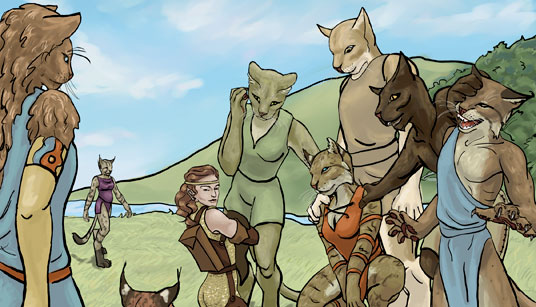




The ferenabu are a species of sentient and sapient bipedal felines living in the remote areas of the cold southernmost continent, beyond the lands of the orcs, and far away from the other sapient races. They were discovered by the avali a few millennia ago, but remain a fictional story to most people. For many humans the ferenabu, also referred to as the "fere" which easily mutates into "furry" on the tongue of the human, are simply impossible myth; cats that talk and walk on two legs — preposterous! For others they are figures of magic, whimsy, and romance: children and adults alike dream of befriending the ferenabu and being "discovered" as one of the rare humans with an aptitude for sourcery.
Sourcery is a different sort of power, and it is enshrouded in no small amount of mystique because the avali — the undisputed masters of magic — do not understand it. The only human sourcerers known to exist were all students at the (rather high) knees of ferenabu masters. It is commonly believed that every "two legged cat" possesses the magic of sourcery in abundance. Perhaps the humans are not wholly incorrect, as it is almost magical how successful the ferenabu have been in both avoiding conflict with other species and preserving the territories they wander in in large packs. How the ferenabu came to exist is not known. Their oral histories do not include mention of any deity or creation myth. According to most ferenabu they have been around as long as they've been around.
A ferenabu has a keen innate awareness of their physical self resulting in agility, strong immune system, and a knack for understanding what food/activity is healthy and what isn't. A ferenabu would never over-exert themselves or continue any harmful activity without good cause — albeit their idea of "good cause" can be novel. They are an entire species of new-agey, yoga-loving, organic-food-eating, commune-living, fur-covered hippies (ok, they don't really do yoga). Hippies that enjoy wrestling and prefer raw elk flesh to soy, that is.
Ferenabu are mostly found in cold climates, primarily located in the southern reaches beyond the land of the orcs and far from avali and the human city-states. They are comfortable in warmer climates as well, and have been found in small pockets in tropical lands, but by and large they prefer temperate and tundra regions.
Most ferenabu have at least some sensitivity for sourcery, though it's not unheard-of for one to be almost completely inert. They can sense life, transcend most pain, and form empathic bonds with their loved ones. Ferenabu abilities can often be developed past these basics with the usual mix of aptitude and hard work. With it they can heal wounds and diseases, communicate empathically, move objects, expand their conciousness beyond their bodies, and enhance their physical prowess to become even more agile and fast. Where avaian magic is ritualistic and requires a strong mind, sourcery is a matter of instinct and spirit. Tribal leaders are often adept in sourcery as their ability to know what is good and healthy for themselves can expand to a larger group.
The concept of tradition is mostly lost on ferenabu. As a species they have not evolved socially much over the years. They are still very much a tribal people who live in tents, like to travel, love their families, and like to play rough'n'tumble games. This slow march of years is because it is not in their nature to dwell much on the past or the future. They are not ambitious, though they are curious.
The ferenabu opinion of other races is mostly one of bemusement. Humans, avali, and others are almost always at odds with the world, with themselves, and with each other. The rules, procedures, and customs that surround humans are incomprehensible to a fere, and thus they tend to ignore such things. Many a human who has overcome their starry-eyed view of the Fere is left concluding that they are nice to have as visitors, but make problematic housemates and difficult business partners. Still, the Fere find humans interesting and likeable most of the time and humans find Fere fascinating and a change from the humdrum of normal life, so there are rarely problems.